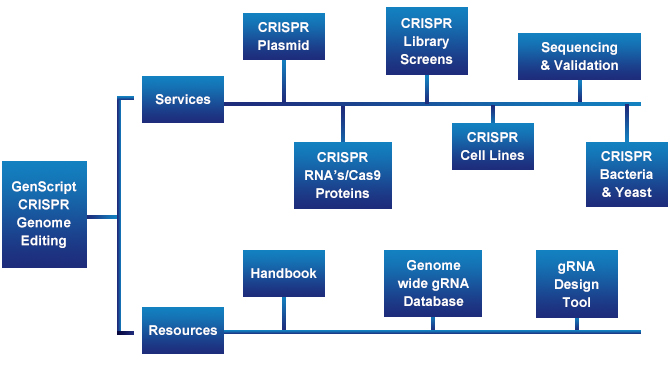-
REAGENT SERVICES
Hot!
-
Most Popular Services
-
Molecular Biology
-
Recombinant Antibody/Protein
-
Reagent Antibody
-
CRISPR Gene Editing
-
DNA Mutant Library
-
IVT RNA and LNP Formulations
-
Oligo Synthesis
-
Peptides
-
Cell Engineering
-
- Gene Synthesis FLASH Gene
- GenBrick™ Up to 200kb
- Gene Fragments Up to 3kb now
- Plasmid DNA Preparation Upgraded
- Cloning and Subcloning
- ORF cDNA Clones
- mRNA Plasmid Solutions New!
- Cell free mRNA Template New!
- AAV Plasmid Solutions New!
- Mutagenesis
- GenCircle™ Double-Stranded DNA New!
- GenSmart™ Online Tools
-
-
PRODUCTS
-
Most Popular Reagents
-
 Instruments
Instruments
-
Antibodies
-
ELISA Kits
-
Protein Electrophoresis and Blotting
-
Protein and Antibody Purification
-
Recombinant Proteins
-
Molecular Biology
-
Stable Cell Lines
-
Cell Isolation and Activation
-
 IVD Raw Materials
IVD Raw Materials
-
 Therapy Applications
Therapy Applications
-
Resources
-
- All Instruments
- Automated Protein and Antibody Purification SystemNew!
- Automated Plasmid MaxiprepHot!
- Automated Plasmid/Protein/Antibody Mini-scale Purification
- eBlot™ Protein Transfer System
- eStain™ Protein Staining System
- eZwest™ Lite Automated Western Blotting Device
- CytoSinct™ 1000 Cell Isolation Instrument
-
- Pharmacokinetics and Immunogenicity ELISA Kits
- Viral Titration QC ELISA Kits
- -- Lentivirus Titer p24 ELISA KitHot!
- -- MuLV Titer p30 ELISA KitNew!
- -- AAV2 and AAVX Titer Capsid ELISA Kits
- Residual Detection ELISA Kits
- -- T7 RNA Polymerase ELISA KitNew!
- -- BSA ELISA Kit, 2G
- -- Cas9 ELISA KitHot!
- -- Protein A ELISA KitHot!
- -- His tagged protein detection & purification
- dsRNA ELISA Kit
- Endonuclease ELISA Kit
- COVID-19 Detection cPass™ Technology Kits
-
- Automated Maxi-Plasmid PurificationHot!
- Automated Mini-Plasmid PurificationNew!
- PCR Reagents
- S.marcescens Nuclease Benz-Neburase™
- DNA Assembly GenBuilder™
- Cas9 / Cas12a / Cas13a Nucleases
- Base and Prime Editing Nucleases
- GMP Cas9 Nucleases
- CRISPR sgRNA Synthesis
- HDR Knock-in Template
- CRISPR Gene Editing Kits and Antibodies
-
![AmMag™ Quatro Automated Plasmid Purification]() AmMag™ Quatro automated plasmid purification
AmMag™ Quatro automated plasmid purification
-
![Anti-Camelid VHH]() MonoRab™ Anti-VHH Antibodies
MonoRab™ Anti-VHH Antibodies
-
![ELISA Kits]() ELISA Kits
ELISA Kits
-
![Precast Gels]() SurePAGE™ Precast Gels
SurePAGE™ Precast Gels
-
![Quatro ProAb Automated Protein and Antibody Purification System]() AmMag™ Quatro ProAb Automated Protein and Antibody Purification System
AmMag™ Quatro ProAb Automated Protein and Antibody Purification System
-
![Target Proteins]() Target Proteins
Target Proteins
-
![AmMag™ Quatro Automated Plasmid Purification]() AmMag™ Quatro automated plasmid purification
AmMag™ Quatro automated plasmid purification
-
![Stable Cell Lines]() Stable Cell Lines
Stable Cell Lines
-
![Cell Isolation and Activation]() Cell Isolation and Activation
Cell Isolation and Activation
-
 IVD Raw Materials
IVD Raw Materials
-
![Quick
Order]() Quick Order
Quick Order
-
![Quick
Order]() Quick Order
Quick Order
- APPLICATIONS
- RESOURCES
- ABOUT US
- SIGN IN My Account SIGN OUT
- REGISTER

![Novel Applications of CRISPR/Cas9 Genome Editing Technology Novel Applications of CRISPR/Cas9 Genome Editing Technology]()
Novel Applications of CRISPR/Cas9 Genome Editing Technology
News & Blogs » CRISPR News » What is CRISPR - Genscript
What Is CRISPR?
When a virus infects a bacterium, it injects its viral DNA through the bacterial cell wall (1) and into the nucleus where it becomes integrated into the host's genome (2). From there, the viral DNA will replicate become translated/transcribed into proteins which will eventually form a newly synthesized virus. In order to defend against viral infection, bacterium evolved the CRISPR/Cas9 system adaptive immune system. Within this system, bacterial CRISPR (Clustered Regularly Interspaced Short Palindromic Repeats) spacer sequences are transcribed into RNA (3) which guides a Cas9 endonuclease to matching regions of viral DNA within the hosts genome. The Cas9 endonuclease then unwinds the host cell DNA and cleaves/removes the infectious viral DNA from the bacterium (4).

Common CRISPR Applications
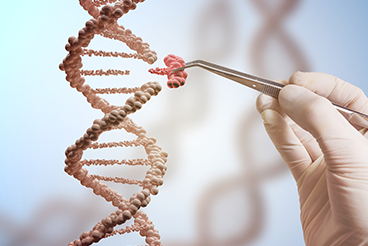 CRISPR/Cas9 has become a popular gene editing tool for prokaryotic
and eukaryotic systems. Due to its popularity, there are a variety
of applications that CRISPR/Cas9 has been used for. One of the most
common applications is using CRISPR/Cas9 for gene silencing. There
are several components of the CRISPR/Cas9 system, target site
specific CRISPR RNA (crRNA), trans-activating crRNA (tracrRNA) or
single guide RNA (sgRNA), and Cas9 endonuclease. When a specific
sequence is targeted and cleaved by the Cas9 protein within the
genome, it creates a double stranded break (1). This double stranded
break is repaired by the endogenous DNA repair pathway,
non-homologous end joining (NHEJ). NHEJ is a mechanism that can
cause errors in the genome and some of the most common errors are
deletions or insertions (indels). These indels can result in
frameshift mutations which can lead to premature termination of the
gene or permanent silencing of the gene (2). Another common
application CRISPR is used for is for transcriptional activation or
repression. There have been several research groups who have
developed a CRISPR/Cas9 ribonucleoprotein complex that can activate
(CRISPRa) or interfere (CRISPRi) with transcription (3). CRISPR/Cas
9 can also be used in epigenetic editing where researchers can
introduce epigenetic modifications into the genome (4). There are
also a number of screening and imaging applications that utilize
CRISPR. Below, we will discuss more applications that are recent
breakthroughs and therefore a little less well known.
CRISPR/Cas9 has become a popular gene editing tool for prokaryotic
and eukaryotic systems. Due to its popularity, there are a variety
of applications that CRISPR/Cas9 has been used for. One of the most
common applications is using CRISPR/Cas9 for gene silencing. There
are several components of the CRISPR/Cas9 system, target site
specific CRISPR RNA (crRNA), trans-activating crRNA (tracrRNA) or
single guide RNA (sgRNA), and Cas9 endonuclease. When a specific
sequence is targeted and cleaved by the Cas9 protein within the
genome, it creates a double stranded break (1). This double stranded
break is repaired by the endogenous DNA repair pathway,
non-homologous end joining (NHEJ). NHEJ is a mechanism that can
cause errors in the genome and some of the most common errors are
deletions or insertions (indels). These indels can result in
frameshift mutations which can lead to premature termination of the
gene or permanent silencing of the gene (2). Another common
application CRISPR is used for is for transcriptional activation or
repression. There have been several research groups who have
developed a CRISPR/Cas9 ribonucleoprotein complex that can activate
(CRISPRa) or interfere (CRISPRi) with transcription (3). CRISPR/Cas
9 can also be used in epigenetic editing where researchers can
introduce epigenetic modifications into the genome (4). There are
also a number of screening and imaging applications that utilize
CRISPR. Below, we will discuss more applications that are recent
breakthroughs and therefore a little less well known.
- Jinek, M., et al., RNA-programmed genome editing in human cells. Elife, 2013. 2: p. e00471.
- Hsu, Patrick D., Eric S. Lander, and Feng Zhang. “Development and Applications of CRISPR-Cas9 for Genome Engineering.” Cell 157.6 (2014): 1262–1278. PMC. Web. 10 Oct. 2017.
- Bikard, David, et al. "Programmable repression and activation of bacterial gene expression using an engineered CRISPR-Cas system." Nucleic acids research 41.15 (2013): 7429-7437.
- Liao, Jing, et al. "Targeted disruption of DNMT1, DNMT3A and DNMT3B in human embryonic stem cells." Nature genetics 47.5 (2015): 469-478.
Novel CRISPR Applications
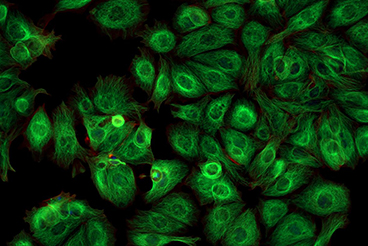 Common protocol to measure the affect of extracellular signals on
protein expression is to transfect a cell line with a plasmid
expressing a reporter (such as luciferase) under the control of
known transcriptional control elements. However, this assay comes
with two main constraints. First, exogenous reporter constructs are
restricted to activation by only one specific signaling pathway, not
allowing for other physiologically relative signaling cascades.
Secondly, these reporter constructs randomly integrate into the host
cell genome, leading top unknown chromatin structure. In order to
circumvent these issues, researchers at Merck, have identified a way
of using CRISPR/CAS9 technology to express a luciferase reporter
under the control of an endogenous promoter. In order to accomplish
this task, they first engineered two CRISPR plasmids, one which
contained a luciferase reporter gene flanked by sequences homologous
to the sequences neighboring the start codon of their gene of
interest and another which containing the Cas9 and optimized guide
RNA. These plasmids were co-transfected into a human leukemia cell
line in order to produce a double stranded break to knockout 1
allele of the target gene while simultaneously knocking-in the
luciferase gene. The final cell line contained one natural allele
and one luciferase allele, both controlled under the same endogenous
enhancer/promoter region. The results of the study revealed that the
novel CRISPR/Cas9 endogenous luciferase reporter was able to
increase luciferase activity and target protein expression in a dose
dependent manor. Therefore, the authors are confident that this
novel CRISPR technology will lead to much more physiological
relevant expression experiments in the near future.
Common protocol to measure the affect of extracellular signals on
protein expression is to transfect a cell line with a plasmid
expressing a reporter (such as luciferase) under the control of
known transcriptional control elements. However, this assay comes
with two main constraints. First, exogenous reporter constructs are
restricted to activation by only one specific signaling pathway, not
allowing for other physiologically relative signaling cascades.
Secondly, these reporter constructs randomly integrate into the host
cell genome, leading top unknown chromatin structure. In order to
circumvent these issues, researchers at Merck, have identified a way
of using CRISPR/CAS9 technology to express a luciferase reporter
under the control of an endogenous promoter. In order to accomplish
this task, they first engineered two CRISPR plasmids, one which
contained a luciferase reporter gene flanked by sequences homologous
to the sequences neighboring the start codon of their gene of
interest and another which containing the Cas9 and optimized guide
RNA. These plasmids were co-transfected into a human leukemia cell
line in order to produce a double stranded break to knockout 1
allele of the target gene while simultaneously knocking-in the
luciferase gene. The final cell line contained one natural allele
and one luciferase allele, both controlled under the same endogenous
enhancer/promoter region. The results of the study revealed that the
novel CRISPR/Cas9 endogenous luciferase reporter was able to
increase luciferase activity and target protein expression in a dose
dependent manor. Therefore, the authors are confident that this
novel CRISPR technology will lead to much more physiological
relevant expression experiments in the near future.
- Liu, Jinqi, et al. "Development of a luciferase reporter Jurkat cell line under the control of endogenous interleukin-2 promoter." Journal of Immunological Methods (2017).
CasFISH: Using CRISPR for In Situ Labeling
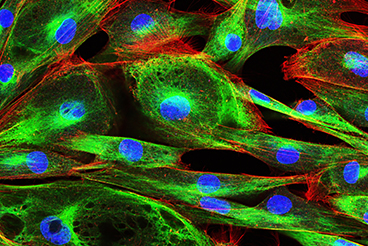 DNA Fluorescent In Situ Hybridization (FISH) is a widely accepted
way to label specific DNA sequences. However, the standard protocol
requires harmful chemicals which induce the denaturation of double
stranded DNA and allow for probe hybridization, despite their known
detrimental effects on biological structure and genome organization.
In order to develop a simpler, less expensive, and less time
consuming FISH protocol, researchers at the Transcription Imaging
Consortium invented a novel way of using the CRISPR/Cas9 system to
fluorescently label specific sequences of DNA. The authors first
constructed a nuclease deficient Cas9 fusion protein which contained
an N terminal hexahistodine tag and a C terminal halo tag bound to a
JFF646 fluorophore. Next, they produced a 5'-DY547 tagged sgRNA
targeting the highly repetitive mouse nucleic sequence, MajSat. Once
generated, the DY547sgMajSat and the JF646-dCas9 were incubated
together within mouse embryonic fibroblast in order to form a
gDNA-sgRNA-dCas9 trimer. This trimer was visualized using a
fluorescent microscope to show that both the DY547sgMajSat and the
JF646-dCas9 co-labeled with the nuclear stain DAPI, indicating that
CasFISH successfully fluorescently labeled specific DNA sequences as
intended. In order to reduce the cost of this novel technology, the
authors were able to successfully label their gene of interest using
only fluorophore labeled Cas9, rather than also labeling the gRNA.
To optimize the technique even further, the researchers identified a
protocol for co-labeling several different DNA sequences at the same
time by introducing multiple dCas9 proteins bound to different
fluorophores simultaneously with their corresponding sgRNA's. This
study was the first of its kind to not only introduce the concept of
using CRISPR/Cas9 to replace DNA FISH, but also reveal its potential
to replace it all together, due to CasFISH's significant reduction
in cost, time, and difficulty.
DNA Fluorescent In Situ Hybridization (FISH) is a widely accepted
way to label specific DNA sequences. However, the standard protocol
requires harmful chemicals which induce the denaturation of double
stranded DNA and allow for probe hybridization, despite their known
detrimental effects on biological structure and genome organization.
In order to develop a simpler, less expensive, and less time
consuming FISH protocol, researchers at the Transcription Imaging
Consortium invented a novel way of using the CRISPR/Cas9 system to
fluorescently label specific sequences of DNA. The authors first
constructed a nuclease deficient Cas9 fusion protein which contained
an N terminal hexahistodine tag and a C terminal halo tag bound to a
JFF646 fluorophore. Next, they produced a 5'-DY547 tagged sgRNA
targeting the highly repetitive mouse nucleic sequence, MajSat. Once
generated, the DY547sgMajSat and the JF646-dCas9 were incubated
together within mouse embryonic fibroblast in order to form a
gDNA-sgRNA-dCas9 trimer. This trimer was visualized using a
fluorescent microscope to show that both the DY547sgMajSat and the
JF646-dCas9 co-labeled with the nuclear stain DAPI, indicating that
CasFISH successfully fluorescently labeled specific DNA sequences as
intended. In order to reduce the cost of this novel technology, the
authors were able to successfully label their gene of interest using
only fluorophore labeled Cas9, rather than also labeling the gRNA.
To optimize the technique even further, the researchers identified a
protocol for co-labeling several different DNA sequences at the same
time by introducing multiple dCas9 proteins bound to different
fluorophores simultaneously with their corresponding sgRNA's. This
study was the first of its kind to not only introduce the concept of
using CRISPR/Cas9 to replace DNA FISH, but also reveal its potential
to replace it all together, due to CasFISH's significant reduction
in cost, time, and difficulty.
- Deng, Wulan, et al. "CASFISH: CRISPR/Cas9-mediated in situ labeling of genomic loci in fixed cells." Proceedings of the National Academy of Sciences 112.38 (2015): 11870-11875.
Gene Therapy CRISPR/Cas9 Application
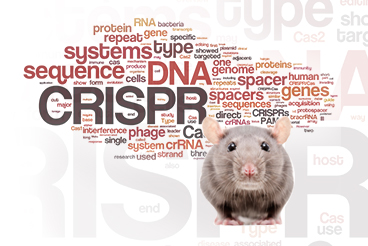 Due to its versatility, CRISPR/Cas9 genome editing tools have been
used throughout different medical research areas and has shown some
promising results as a potential therapy for several disease models.
One method of CRISPR/Cas9 that has shown great potential in the gene
therapy research area is homology directed repair (HDR). CRISPR/Cas9
is used to create a double stranded break in the DNA and ideally,
one could insert a donor template to alter the coding region to
potentially correct a mutation. There have been several studies
discussing HDR's potential to "fix" different genetic mutations:
Due to its versatility, CRISPR/Cas9 genome editing tools have been
used throughout different medical research areas and has shown some
promising results as a potential therapy for several disease models.
One method of CRISPR/Cas9 that has shown great potential in the gene
therapy research area is homology directed repair (HDR). CRISPR/Cas9
is used to create a double stranded break in the DNA and ideally,
one could insert a donor template to alter the coding region to
potentially correct a mutation. There have been several studies
discussing HDR's potential to "fix" different genetic mutations:
- Cong, L., et al., Multiplex genome engineering using CRISPR/Cas systems. Science, 2013. 339(6121): p. 819-23.
- Wu, Wen-Hsuan, et al. "CRISPR repair reveals causative mutation in a preclinical model of retinitis pigmentosa." Molecular Therapy 24.8 (2016): 1388-1394.
- Yin, Hao, et al. "Therapeutic genome editing by combined viral and non-viral delivery of CRISPR system components in vivo." Nature biotechnology 34.3 (2016): 328.
- Dai, Wei-Jing, et al. "CRISPR-Cas9 for in vivo gene therapy: promise and hurdles." Molecular Therapy-Nucleic Acids 5 (2016): e349.
- Kemaladewi, Dwi U., et al. "Correction of a splicing defect in a mouse model of congenital muscular dystrophy type 1A using a homology-directed-repair-independent mechanism." Nature medicine 23.8 (2017): 984.
- Yang, Su, et al. "CRISPR/Cas9-mediated gene editing ameliorates neurotoxicity in mouse model of Huntington's disease." The Journal of clinical investigation 127.7 (2017).
Subscribe to Receive Updates
& Promotions From GenScript* We'll never share your email address with a third-party.
Latest News & Blogs
Find More CRISPR News
CRISPR Screening to Optimize CAR Therapies | GenScript
Jul 08, 2025

Engineered NK cells, off-the-shelf solution | GenScript
Jun 17, 2025

Multiplex Editing T Cells with BE and Cas12 | GenScript
May 28, 2025
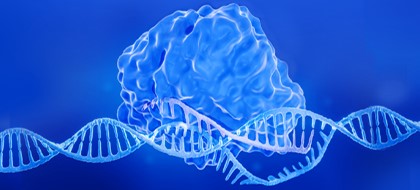
Theory to action: Applying CRISPR in Research
Aug 16, 2023

Evolving in vivo Gene and Editing-Cargo Delivery Strategies | GenScript
Jul 21, 2023

Enabling Non-Viral T Cell Engineering with ssDNA HDR Templates
Nov 08, 2022

-






































